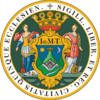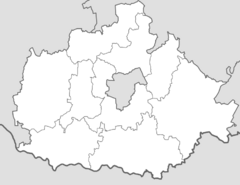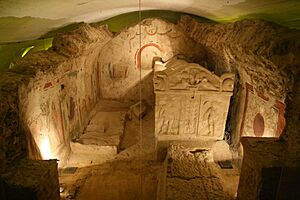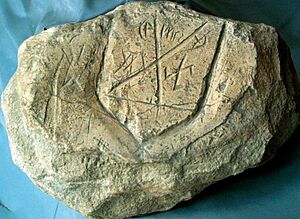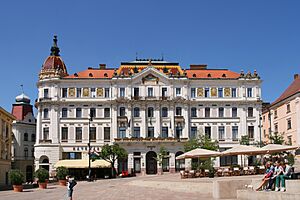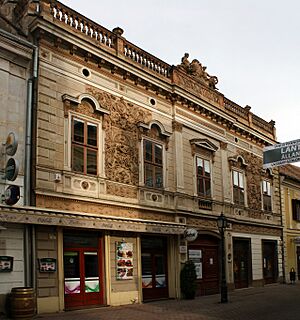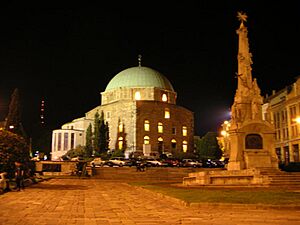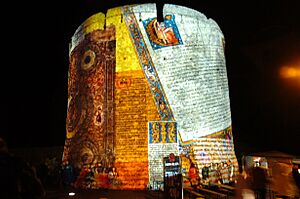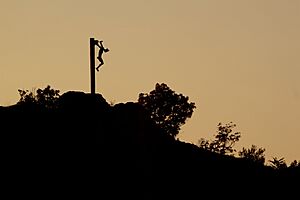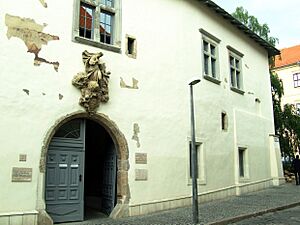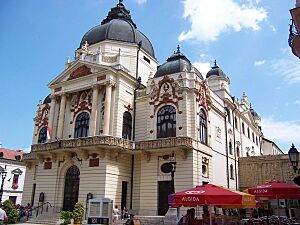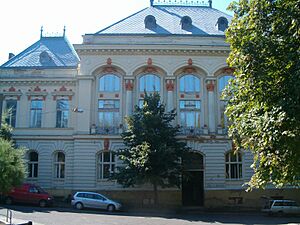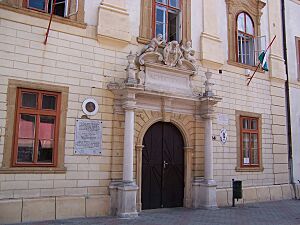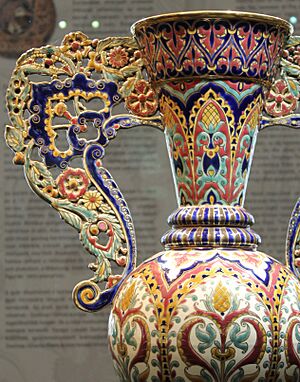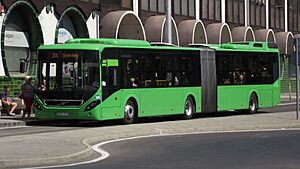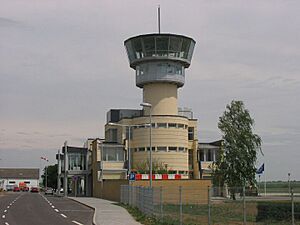Pécs facts for kids
Quick facts for kids
Pécs
|
|||
|---|---|---|---|
|
City with county rights
|
|||
| Pécs Megyei Jogú Város | |||

Clockwise from top left: Cathedral, Széchenyi Square, Barbican, Yakovalı Hasan Paşa Mosque, Kossuth Square
|
|||
|
|||
| Nickname(s):
"The City of Culture" (A kultúra városa)
|
|||
| Country | |||
| Region | Southern Transdanubia | ||
| County | Baranya | ||
| District | Pécs | ||
| Established | 2nd century BC | ||
| City status | 1777 (renewed) | ||
| Area | |||
| • City with county rights | 162.61 km2 (62.78 sq mi) | ||
| Area rank | 32nd in Hungary | ||
| Elevation | 153 m (502 ft) | ||
| Population | |||
| • City with county rights | 145,347 |
||
| • Rank | 5th in Hungary | ||
| • Density | 963.43/km2 (2,495.3/sq mi) | ||
| • Urban | 251,412 (4th) | ||
| Demonym(s) | pécsi | ||
| Population by ethnicity | |||
| • Hungarians | 84.0% | ||
| • Germans | 4.2% | ||
| • Romani | 2.0% | ||
| • Croats | 1.2% | ||
| • Romanians | 0.2% | ||
| • Serbs | 0.2% | ||
| • Slovaks | 0.1% | ||
| • Greeks | 0.1% | ||
| • Turks | 0.1% | ||
| Population by religion | |||
| • Roman Catholic | 39.7% | ||
| • Greek Catholic | 0.3% | ||
| • Calvinists | 5.2% | ||
| • Lutherans | 1.3% | ||
| • Jews | 0.1% | ||
| • Islam | 0.1% | ||
| • Non-religious | 27.8% | ||
| Time zone | UTC+01:00 (CET) | ||
| • Summer (DST) | UTC+02:00 (CEST) | ||
| Postal code |
7600 to 7636
|
||
| Area code | (+36) 72 | ||
| Motorways | M60 Motorway | ||
| NUTS 3 code | HU231 | ||
| Distance from Budapest | 238 km (148 mi) Northeast | ||
| Airport | Pécs (PEV) | ||
| MPs |
List
Tamás Mellár (Independent)
Péter Hoppál (Fidesz) |
||
| Official name: Early Christian Necropolis of Pécs (Sopianae) | |||
| Criteria: | iii, iv | ||
| Designated: | 2000 | ||
Pécs (pronounced "PAYTCH") is the fifth biggest city in Hungary. It sits at the foot of the Mecsek mountains in the southwest of the country. It's also close to the border with Croatia. Pécs is the main city for government and business in Baranya County. It is also an important center for the Roman Catholic Church.
This city has a very long history, going back to ancient times. It was first settled by the Celts and then the Romans. Later, it became an important church center in early medieval Hungary. Pécs is home to the oldest university in Hungary. It is also one of the country's main cultural hubs. The city has a rich cultural past from the 150 years it was under Ottoman rule. It has always been a city where many different cultures have lived together for over 2000 years. Because of its amazing cultural heritage, Pécs was named one of the European Capital of Culture cities. The ancient Roman Christian burial ground in Pécs became a World Heritage Site in 2000.
Contents
What's in a Name?
The very first name for this area was its Roman name, Sopianæ. This name might come from a Celtic word meaning "marsh" or "swamp".
The city in the Middle Ages was first mentioned in 871. It was called Quinque Basilicae, which means "five cathedrals". This name came about because builders used materials from five old Christian chapels to construct the city's churches. Later Latin documents called it Quinque Ecclesiae, meaning "five churches". This is similar to the German name Fünfkirchen and the Slovak name Päťkostolie.
The name Pécs appeared in documents in 1235. It was in the word Pechyut, which means "road to/from Pécs". This name likely comes from an old Slavic or Illyrian word also meaning "five". In other languages, Pécs is known as Pečuh in Croatian and Peçuy in Turkish.
Where is Pécs?
Pécs is located in the Carpathian Basin in Central Europe. It's in the middle of Baranya County in southern Hungary. To the north, you'll find the Mecsek hills. To the south, there's a flat, rolling plain.
The city has a history of mining. The water from the Mecsek mountains is known for its many minerals. Pécs is also close to the Croatian border. The southern part of the city is flat, while the northern part climbs up the Mecsek mountains. The climate here is very nice, with lots of woods nearby. On hot summer nights, cool air flows down from the Mecsek hills, making the city feel fresh.
The plains south of Pécs are about 120–130 meters high. The Mecsek mountains behind the city rise to 400–600 meters. The highest points near Pécs are Jakab-hill (592 m), Tubes (612 m), and Misina (535 m). Higher parts of the city, like Pécsbánya and Vasas, are around 200–250 meters high. The wooded areas usually start at about 300 meters. The Mecsek hills have many valleys. These valleys help improve the city's climate, as there are no large lakes or rivers nearby. Water from the Mecsek hills flows into the Pécsi stream. This stream eventually reaches the Danube river.
A Look Back: History of Pécs
| UNESCO World Heritage Site | |
|---|---|
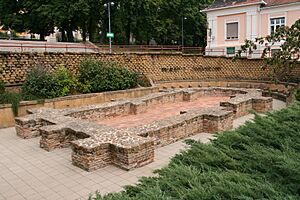
Remnants of a Paleochristian Church, 4th century AD
|
|
| Criteria | Cultural: iii, iv |
| Inscription | 2000 (24th Session) |
| Area | 3.76 ha |
| Buffer zone | 4.87 ha |
Ancient Roman Times
People have lived in this area for a very long time. The oldest things found by archaeologists are 6,000 years old. Before the Romans arrived, Celts lived here.
The city of Sopianae was started by the Romans in the early 2nd century. This was a place where Celtic and Pannoni tribes lived. At that time, much of western Hungary was a Roman province called Pannonia. The Romans set up several wine-making towns here, calling them Sopianae.
The center of Sopianae was where the Bishop's Palace is today. You can still see parts of the old Roman aqueduct. When the Roman province of Pannonia was divided, Sopianae became the capital of the Valeria region.
By the 4th century, Sopianae was a major early Christian center. The old Christian burial ground in the city is from this time. These Christian tombs are special because of their design. They have underground burial rooms with chapels built above them. Many are decorated with Christian paintings. These tombs became a UNESCO World Heritage Site in December 2000. By the end of the 4th century, Roman rule in the area became weaker due to attacks from other groups.
Early Middle Ages
When Charlemagne came to the area in 791, the Avars ruled it. After Charlemagne conquered the area, it became part of the Holy Roman Empire. It was also part of the Diocese of Salzburg.
A document from Salzburg in 871 is the first to mention the early medieval city. It was called Quinque Basilicae. During the 9th century, Slavs and Avars lived in the city. It was part of the Balaton Principality, which was linked to the Franks.
Hungarian City in the Middle Ages
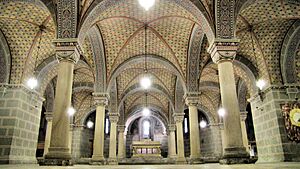
After the Hungarians conquered the Carpathian Basin, they kept a semi-nomadic lifestyle. They moved their animals between winter and summer pastures. Some believe that Árpád's winter camp was in Pécs around 900 AD. Later, when Baranya county was formed, its capital was Baranyavár, not Pécs. However, Pécs became an important religious center. Latin documents called it Quinque Ecclesiae. Around 1000, the area was home to the Black Magyars. The Diocese of Pécs was officially started in 1009.
The Roman Catholic Diocese of Pécs was founded in 1009 by King Stephen I. The first university in Hungary was started in Pécs in 1367 by King Louis I the Great. Today, the largest university in Pécs has about 34,000 students.
Peter Orseolo, the second king of Hungary, was buried in the cathedral in 1046. His grave's exact spot is unknown. In 1064, the cathedral burned down. The cathedral you see today was built after this fire, in the second half of the 11th century.
Many religious groups came to Pécs. The Benedictine order was the first in 1076. By 1181, the city already had a hospital. The first Dominican monastery in Hungary was built in Pécs in 1238.
King Louis the Great founded a university in Pécs in 1367. He did this after listening to William, the bishop of Pécs. William was also the king's chancellor. This was the first university in Hungary. Its founding document is very similar to the University of Vienna's. It said the university could teach all arts and sciences, except for theology.
In 1459, Janus Pannonius, a very important medieval Hungarian poet, became the bishop of Pécs. He helped make the city even more important for culture. Bishop Janus Pannonius, a great humanist poet, made Pécs a center for culture and arts.
Ottoman Rule
After the Battle of Mohács in 1526, the Ottoman army defeated the Hungarian army. The armies of Suleiman then took over Pécs. A large part of Hungary was under Ottoman control. Also, people disagreed about who should be the king of Hungary. Some supported Ferdinand of Habsburg, while others crowned John Zápolya. In the summer of 1527, Ferdinand defeated John's armies and became king. Ferdinand liked Pécs because they supported him. He made it so Pécs didn't have to pay taxes. The city was rebuilt and made stronger.
In 1529, the Ottomans captured Pécs again. They were on their way to attack Vienna. The Ottomans made Pécs accept King John, who was their ally, as ruler. John died in 1540. In 1541, the Ottomans took over the castle of Buda. They told Isabella, John's widow, to give Pécs to them. This was because the city was very important for their military plans. The people of Pécs fought against the Ottomans. They promised to be loyal to Ferdinand. The emperor helped the city and protected it from more Ottoman attacks. But his advisors told him to focus on other cities instead of Pécs. Pécs was getting ready for a siege. But the day before, some foreign soldiers ran away from the city and attacked nearby lands. The next day, in June 1543, the Bishop himself gave the city's keys to the Ottomans.
After taking the city, the Ottomans made it stronger. They turned it into a true Ottoman city. Christian churches became mosques. Turkish baths and minarets were built. Schools for the Qur'an were started. The market became a bazaar. For 100 years, the city was peaceful in a time of war. It was an important center in the Ottoman Empire.
The Ottoman era left many important buildings. These include the mosque of Pasha Qasim the Victorious in Széchenyi Square. There is also the Tomb of İdris Baba and the Yakovalı Hasan Paşa Mosque.
The Ottoman writer İbrahim Peçevi (Ibrahim of Pécs) was from this city. His writings are a main source for Ottoman history between 1520 and 1640.
In 1664, Croat-Hungarian nobleman Nicholas Zrínyi came to Pécs with his army. They knew they couldn't hold the city for long, so they planned to only raid it. They destroyed and burned the city but couldn't take the castle. Medieval Pécs was ruined forever. Only the city wall, one tower (Barbakán), and a network of tunnels remained. Some Turkish buildings also survived. These include three mosques, two minarets, and parts of a bathhouse.
After the castle of Buda was taken from Ottoman rule in 1686, armies went to capture Pécs. The first soldiers broke into the city and looted it. The Ottomans saw they couldn't keep the city. They burned it and went into the castle. The army led by Louis of Baden took the city on October 14. They destroyed the water supply to the castle. The Ottomans had to surrender, which they did on October 22.
The city was under military rule. The leaders in Vienna first wanted to destroy the city. But then they decided to keep it. This was to balance the importance of Szigetvár, which was still under Ottoman rule. Slowly, the city began to grow again. But in the 1690s, two outbreaks of the plague killed many people. In 1688, German settlers arrived. Only about a quarter of the city's people were Hungarian. The rest were Germans or Southern Slavs. Because Hungarians were a minority, Pécs did not support the revolution against Habsburg rule. This revolution was led by Francis II Rákóczi. His armies looted the city in 1704.
Early Modern Times
A more peaceful time began after 1710. Businesses, trade, and wine-making grew. New factories were built, and a new city hall was constructed. The city was ruled by the Bishop of Pécs. But the city wanted to be free from the bishop's control. Bishop George Klimó was a wise man. He started the first public library in Hungary. He would have given up his rights to the city, but the Holy See (the Pope's office) told him not to. When Klimó died in 1777, Queen Maria Theresa quickly made Pécs a free royal town. This happened before a new bishop was chosen. This cost the city 83,315 forints.
The first census (a count of people) was done in 1787. It showed that Pécs had 1,474 houses and 1,834 families. There were 8,853 people in total. This included 133 priests and 117 noblemen.
In 1785, the Academy of Győr moved to Pécs. This academy later became a law school. The city's first stone theater was built in 1839. Around this time, German settlers from the Danube Swabians group also moved to the city.
19th Century and Beyond
Industry grew a lot in the second half of the 19th century. By 1848, there were 1,739 factory workers. Some factories were famous across the country. The iron and paper factories were very modern for their time. Coal mining was also important. A sugar factory and beer breweries were built too. The city had 14,616 people.
During the revolution in 1848–49, Croatian armies briefly took over Pécs. But Habsburg armies freed the city in January 1849.
After the Austro-Hungarian Compromise of 1867, Pécs grew, like other cities in Hungary. From 1867, Pécs was connected to the nearby town Barcs by railway. By 1882, it was also connected to Budapest. In 1913, a tram system was started, but it stopped running in 1960.
At the end of World War I, Serbian troops occupied Baranya county. It wasn't until August 1921 that Pécs was sure it would stay part of Hungary. The University of Pressburg (now Bratislava, Slovakia) moved to Pécs. This happened after Hungary lost Pressburg due to the Treaty of Trianon.
During World War II, Soviet troops captured Pécs on November 29, 1944. This was part of the Budapest Offensive. The city only had minor damage. A big tank battle happened about 20-25 km south of the city. This was near the Villány area late in the war. The advancing Red Army was fighting its way towards Austria. Until the end of World War II, most people living in Pécs were Danube Swabians. Some of the German settlers were sent to Germany and Austria from 1945-1948. This was under the 1945 Potsdam Agreement. Germans of Hungary are still a minority in the city today.
After the war, the city grew quickly. It took in several nearby towns. By the 1980s, Pécs had 180,000 people.
| Historical population | ||
|---|---|---|
| Year | Pop. | ±% |
| 1870 | 30,821 | — |
| 1890 | 43,869 | +42.3% |
| 1900 | 53,721 | +22.5% |
| 1910 | 60,237 | +12.1% |
| 1920 | 58,808 | −2.4% |
| 1930 | 74,395 | +26.5% |
| 1941 | 88,473 | +18.9% |
| 1949 | 88,302 | −0.2% |
| 1960 | 114,655 | +29.8% |
| 1970 | 149,253 | +30.2% |
| 1980 | 168,715 | +13.0% |
| 1990 | 170,039 | +0.8% |
| 2001 | 162,489 | −4.4% |
| 2011 | 156,049 | −4.0% |
| 2022 | 139,647 | −10.5% |
After the end of the Socialist era (1989–1990), Pécs faced challenges. Like many other areas, it was hit hard by the changes. Many mines and factories closed, leading to high unemployment. The war in nearby Yugoslavia in the 1990s also affected tourism.
Pécs was also a center for the Nordic Support Group (NSG). This group included units from Denmark, Norway, Sweden, Finland, and Poland. They were part of the IFOR and later SFOR NATO missions. These missions happened after the Dayton Agreement brought peace to former Yugoslavia. The first units arrived in Pécs in late 1995 and early 1996. The NSG helped with supplies, people, and other support for their forces in Bosnia-Herzegovina.
In 1998, Pécs won the UNESCO prize "Cities for Peace". This was for supporting its cultural minorities. It was also for being kind and helpful to refugees from the Yugoslav Wars.
In 2007, Pécs was the third "Livable City" (The LivCom Awards). In 2008, it was second in the category for cities with 75,000 to 200,000 people.
In 2010, Pécs was chosen to be a European Capital of Culture. It shared this title with Essen and Istanbul. The city's motto was "The Borderless City". After getting this title, major improvements began in the city. Public places, streets, squares, and neighborhoods were renovated. New cultural centers, a concert hall, a new library, and a cultural area were built.
Main Sights to See
The city's history is clear in its main square. Here, the Gazi Kasim Mosque still stands. Even though it became a church after the Ottoman Turks left, the crescent moon of Islam is still on its dome, topped by a cross. Pécs has the most Turkish buildings in Hungary. Other notable remains include the ruins of Memi Pasa's Baths and the tomb of the miracle worker Idris Baba. The Yakovalı Hasan Paşa Mosque, built in the mid-1600s, is still an active mosque today. You can visit it except during Friday services from 2:30 to 3:30 pm.
Some of the main sights include:
- The Early Christian Necropolis of Pécs: These are large Roman tombs and mausoleums from around the 4th century. It is a UNESCO World Heritage Site.
- Cella Septichora (4th century)
- The Cathedral (11th century, updated in the 19th century).
- Hungarian Bishop's Palace (12th century)
- University of Pécs (founded 1367): You can see the buildings of the Faculty of Science and Faculty of Humanities on Ifjúság street. It also has a Botanical Garden.
- Klimo Library (1774): This was the first public library in Hungary. Bishop George Klimo started it.
- Barbakán "Tower" (15th century)
- Ruins in Tettye (1505–1521)
- Széchenyi Square (the main square)
- The mosque of pasha Qasim (1543–1546): This was originally a Gothic church from the 13th century.
- Yakovalı Hasan Paşa Mosque (17th century)
- Downtown: Many houses from the Middle Ages and later styles like Baroque, Classicism, Rococo, and Art Nouveau.
- Nádor Hotel (1846) in Széchenyi Square
- County House in Széchenyi Square
- City Hall in Széchenyi Square
- Synagogue (1869)
- Building of the Hungarian Academy of Sciences (1884)
- National Theatre of Pécs (Nemzeti Színház), opened in 1895.
- Eosin glaze of Zsolnay fountain
- Posta (Post) Palace
- Hungaricum House
- Janus Pannonius Museum
- Renaissance Museum
- Csontváry Museum
- Zsolnay Museum
- Zsolnay Mausoleum
- Victor Vasarely Museum
- Amerigo Tot Museum
- Ethnographic Museum in Pécs
- Natural History Museum in Pécs
- Szerecsen Chemist's Museum
- Gallery of Pécs
- Museum Street
- Zsolnay Mausoleum
- Bóbita (a puppet show)
- Janus (Pannonius) Theatre
- Croatian Theatre in Pécs
- Third Theatre
- Zoological Garden in Pécs
- Love padlocks
- TV-Tower in Mecsek Mountain (1960)
People and Cultures
Most people in Pécs, about 84.0%, are Hungarians. This is based on the 2011 census. The city's Germans are the biggest minority group, making up 4.2% of the population. After them are the Roma (2.0%), Croats (1.2%), and Romanians (0.2%).
The largest religious group is Catholics, with 39.7% being Roman Catholic and 0.3% Greek Catholic. The next largest group is Calvinists (5.2%), followed by Lutherans (1.3%). About 27.8% of the people say they are not religious.
Many international students study and live in Pécs. This brings a lot of different cultures and people to the city.
Weather in Pécs
Pécs has a climate called "humid subtropical." This means it has warm, humid summers and mild winters. The average temperature for the year is about 11.5°C (52.7°F). The hottest months are July and August, with temperatures around 22.0°C (71.6°F). The coldest month is January, with an average of 0.4°C (32.7°F).
The city gets about 670.9 mm (26.4 inches) of rain each year. June is the wettest month, while January is the driest. The temperature has ranged from a very cold -27.0°C (-16.6°F) in January 1942 to a very hot 41.3°C (106.3°F) in July 1950.
| Climate data for Pécs, 1991−2020 normals, extremes 1901-2020 | |||||||||||||
|---|---|---|---|---|---|---|---|---|---|---|---|---|---|
| Month | Jan | Feb | Mar | Apr | May | Jun | Jul | Aug | Sep | Oct | Nov | Dec | Year |
| Record high °C (°F) | 17.0 (62.6) |
20.9 (69.6) |
26.4 (79.5) |
29.9 (85.8) |
33.8 (92.8) |
38.9 (102.0) |
41.3 (106.3) |
39.6 (103.3) |
35.2 (95.4) |
29.4 (84.9) |
24.4 (75.9) |
19.5 (67.1) |
41.3 (106.3) |
| Mean daily maximum °C (°F) | 3.5 (38.3) |
6.2 (43.2) |
11.5 (52.7) |
17.3 (63.1) |
21.8 (71.2) |
25.6 (78.1) |
27.7 (81.9) |
27.6 (81.7) |
22.2 (72.0) |
16.6 (61.9) |
9.9 (49.8) |
4.0 (39.2) |
16.2 (61.2) |
| Daily mean °C (°F) | 0.4 (32.7) |
2.1 (35.8) |
6.6 (43.9) |
11.9 (53.4) |
16.4 (61.5) |
20.2 (68.4) |
22.0 (71.6) |
22.0 (71.6) |
16.9 (62.4) |
11.7 (53.1) |
6.1 (43.0) |
1.2 (34.2) |
11.5 (52.7) |
| Mean daily minimum °C (°F) | −2.4 (27.7) |
−1.2 (29.8) |
2.4 (36.3) |
6.9 (44.4) |
11.3 (52.3) |
14.9 (58.8) |
16.5 (61.7) |
16.5 (61.7) |
12.2 (54.0) |
7.5 (45.5) |
3.1 (37.6) |
−1.4 (29.5) |
7.2 (45.0) |
| Record low °C (°F) | −27.0 (−16.6) |
−24.1 (−11.4) |
−16.2 (2.8) |
−6.9 (19.6) |
2.6 (36.7) |
0.8 (33.4) |
5.4 (41.7) |
3.4 (38.1) |
0.4 (32.7) |
−9.0 (15.8) |
−13.0 (8.6) |
−22.1 (−7.8) |
−27.0 (−16.6) |
| Average precipitation mm (inches) | 31.2 (1.23) |
37.4 (1.47) |
33.6 (1.32) |
43.6 (1.72) |
81.3 (3.20) |
82.8 (3.26) |
69.4 (2.73) |
63.5 (2.50) |
71.6 (2.82) |
57.3 (2.26) |
51.8 (2.04) |
47.4 (1.87) |
670.9 (26.41) |
| Average precipitation days (≥ 1.0 mm) | 6.1 | 6.9 | 5.8 | 6.8 | 9.4 | 8.5 | 7.6 | 6.6 | 7.6 | 6.6 | 7.9 | 7.5 | 87.3 |
| Average relative humidity (%) | 82.1 | 75.3 | 66.6 | 62.1 | 65.6 | 66.8 | 63.4 | 63.0 | 68.3 | 74.7 | 82.3 | 84.8 | 71.3 |
| Mean monthly sunshine hours | 68.2 | 92.4 | 145.7 | 186.0 | 235.6 | 258.0 | 294.5 | 266.6 | 207.0 | 164.3 | 81.0 | 58.9 | 2,058.2 |
| Source 1: NOAA | |||||||||||||
| Source 2: HungaroMet (Extremes) Hong Kong Observatory (sun 1961-1990) | |||||||||||||
Economy and Business
Pécs was once famous for its many factories. But after the fall of communism, many of them closed down. For example, the Pécs Glove Factory and the Littke Champagne Factory went out of business. Until recently, Pécs had coal and uranium mines. Now, only a sand mine is still working. It is run by a Hungarian company called Quartz.
The Zsolnay Porcelain factory is a big source of pride for Pécs. It is well-known in Hungary and a bit internationally. Many public and private buildings in the city have walls and roofs decorated with Zsolnay porcelain. This gives Pécs its special look.
The Pécsi Sörfőzde (Pécs Brewery) is one of Hungary's four main breweries. It's the only one fully owned by Hungarians. They make a special beer that is not filtered before bottling.
Many companies have their production facilities in Pécs. These include the Hungarian textile maker Rovitex Hungária and the American crane maker Terex. Other companies make scales, furniture, cutting tools, and switchboards. There are also companies for recycling, farming tools, and animal care products. The tobacco factory Pécsi Dohánygyár is owned by British American Tobacco. Other businesses include car parts, safes, packaging machines, and plastic products.
Modern high-tech industries are also growing in Pécs. The Finnish electronics company Elcoteq is the largest industrial employer. There's also the Hungarian electronics maker Z Elektronika and the IT network maker TG Netcom.
The German transport company, Dachser, has a logistics center in Pécs.
The Biokom company handles waste management and recycling. It is owned by the city. They transport and recycle waste for all of Pécs and nearby areas. The city's energy mainly comes from two biomass power plants run by Pannonpower. These plants use woodchips and farm waste to make electricity. Pécs also has Hungary's largest solar cell field. It produces about 10 MW of energy each year. This is thanks to the city's southern location and many sunny hours. The solar power plant is run by MVM Hungarowind.
The Expo Center Pécs is a place for international exhibitions and conferences.
Learning and Education
The University of Pécs was founded by Louis I of Hungary in 1367. It is the oldest university in Hungary. It is also one of the first universities in Europe. In the past, it was split into two universities. One was for Medicine and Orthodontics (POTE), and a larger one was for other studies (JPTE). The POTE (now called the Medical School) has a big English program for general medicine and dentistry. Students come from America, Asia, Africa, and European countries. There is also a new German program. On January 1, 2000, these universities joined together. They are now called the University of Pécs (PTE). Today, the University of Pécs is the most international university in Hungary. About 5,000 of its 20,000 students are from other countries.
Getting Around Pécs
Roads
- The M6/M60 motorway connects Pécs and Budapest. The drive between the two cities now takes about 2 hours. The whole road opened on March 31, 2010. Route 6 goes through the city from east to west. It then leaves towards Barcs near the Croatian border. Other important roads are:
- Route 57: Pécs - Mohács
- Route 58: Pécs - Drávaszabolcs
- Route 66: Pécs - Kaposvár
Railway
Pécs is connected to Budapest through Pusztaszabolcs. It also has direct train connections to Mohács and Nagykanizsa.
The main railway station was designed by Ferenc Pfaff. It was built in 1900 and became a protected building in 2008. The building looks like Renaissance style. It has carvings of James Watt and George Stephenson. These were designed by Ármin Klein and made by the Zsolnay factory. In front of the station, there is a transport hub. It includes a bus terminal, a bus stop, and a taxi stand.
Tram
A tram system used to run in the city from 1914 to 1960.
Buses
Buses are the main way people get around the city using public transport.
Airport
A new airport opened in Pécs, called Pécs-Pogány International Airport, in March 2006. It mainly handles smaller charter planes.
Sports in Pécs
Pécs is home to several sports teams:
- Pécsi MFC: A football (soccer) club that plays in the Nemzeti Bajnokság II league.
- Pécsi Vasutas SK: Another football club that plays in the regional Baranya county league.
- PEAC-Pécs: A top-level women's professional basketball team.
- Pécsi VSK: A men's water polo team.
- Pécsi Indiánok SK: A rugby club.
Famous People from Pécs
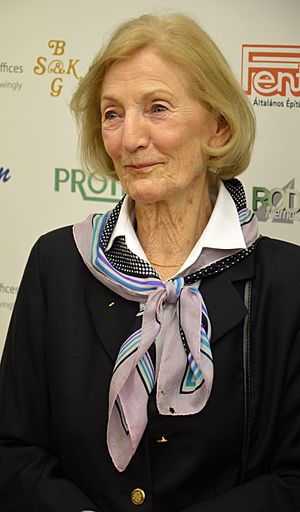

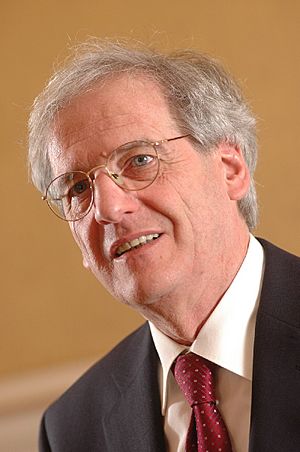
Many notable people were born in Pécs, including:
- Marcel Breuer: A famous architect and furniture designer.
- Pál Dárdai: A football (soccer) player.
- József Eötvös (musician): A guitarist.
- Zoltán Gera: A football (soccer) player.
- Katinka Hosszú: A swimmer who won 3 gold medals at the 2016 Olympic Games.
- Dorka Juhász: A WNBA basketball player.
- Janus Pannonius: A famous bishop and poet of Pécs.
- İbrahim Peçevi: An Ottoman historian.
- László Sólyom: A former president of Hungary.
- Béla Tarr: A film director.
- Olga Tass: An Olympic gymnast.
- Victor Vasarely: A well-known artist.
City Friends Around the World
Pécs has "twin towns" or "sister cities" around the world. These are cities that have special friendly relationships.
Pécs also has a friendly link with Peterborough, England.
Images for kids
-
Lajos Kossuth statue
-
Logo of the 2010 European Capital of Culture
See also
 In Spanish: Pécs para niños
In Spanish: Pécs para niños



